
Freemium to premium: how to enhance your app subscription model

Over the last decade, mobile app development has become an increasingly profitable business. In fact, in 2023, mobile apps are projected to generate more than 770 billion euros in revenue. Part of this growth can be attributed to the world’s shift towards paid subscriptions, which is driven in large part by the success of subscription models from companies like Netflix, Spotify, and others.
While free app subscriptions may incentivise customers to download your app when your business is beginning to find its market fit; sometimes giving away too much can do more harm than good. It’s time to show your customers the true power of your offerings and make your paid model the best model.
So how do you successfully build your app subscription model for your business?
There are three key areas you should consider when enhancing your app subscription model:
- The key revenue drivers for your business
- Where the value lies in your product for your customers
- Retaining subscribers and increasing revenue when developing your freemium to a premium model
Key revenue drivers for building your app subscription model
There are many different revenue drivers and metrics that can be tracked for success. For example, if retention, engagement, and ROI are some of your business goals, determining which in-app events to measure is imperative. All apps and the purpose they serve can vary, so isolating their key benefits will help you determine which levers to pull.

What model are you using?
Research shows subscription models tend to see a higher revenue per user than apps with other business models. Driven, again in large part, by the success of companies such as Netflix and Spotify.
According to Statista 2021, subscription models and similarly freemium models have well-out-performed advertising in-apps or any other model.
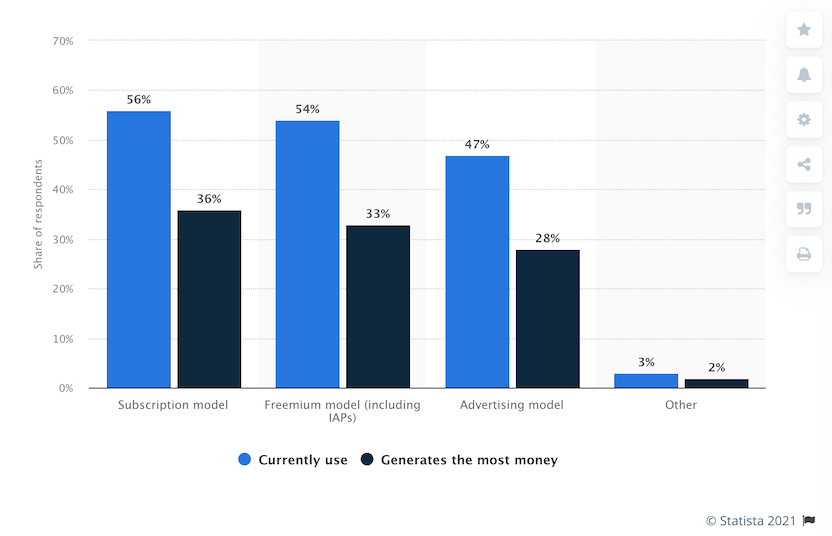
Take Tinder and Spotify, they both operate under the same freemium model but have distinct differences which align with the services they offer. Both apps give users enough access to enjoy the benefits of the app but have a pricing plan in place that generates revenue for the business while keeping loyal customers engaged with the brand they love.
Tinder users are able to swipe at will with a free profile (getting hooked in the process) but Tinder also offers a three-tier pricing model to unlock features that enhances the experience within the app, offering a lot more flexibility.

With Spotify, new users are captivated with a free model but a paid structure is put in place to allow limitless streaming without the hassle of advertising. This is how Spotify responds to people’s gripe with advertising.
So, different companies, different structures, but what do both of these companies have in common? Try before you buy. They pull in users who have a need. Give them limited access to their product without committing to a paid plan. And ultimately convert users to a paid model based on an upgraded experience.
Acquisition costs
Looking at a typical app funnel and some of the costs in the B2C space, customer acquisition cost gets significantly riskier and more costly at the top of the end of the purchase/subscription event.
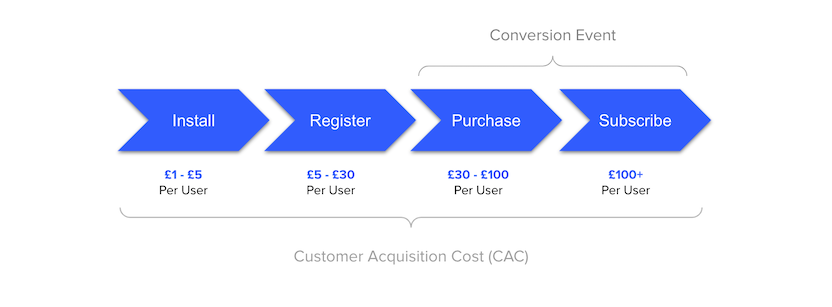
Taking into account the earlier measures like install rate, registrations rates, and conversion rates across the whole funnel, it’s even more essential for your business to focus on all elements of this lifecycle. However, perhaps most critically, you should hone in on the conversion events that enticed your users to make the leap to paid.
Conversions shouldn’t stop once a user installs your app. Here are three key areas to focus on—post-install—to ensure you’re on the right track:
- In-app conversion success: do more of what’s working to optimise for ROI
- Double-down your marketing in areas that are converting highly
- Focus on in-app conversions to offset your customer acquisition costs
Identifying customer value for your product
Those getting it right are the ones who marry their brand with a seamless user experience.
Cohesive brand and reputation, combined with a seamlessly connected user experience, continues to drive new user acquisition in an increasingly competitive market. -Managing Director, Google Apps
When people design their apps with the brand in mind, whether that be the pricing model or functionality, people will begin to connect positive experiences with your brand. Increasingly, people expect a super user experience and won’t think twice before abandoning your app if it doesn’t meet their expectations.
But how do you continue to generate more revenue and ROI if your pricing structure doesn’t match your acquisition costs? Asking your customers about their perceived value can help you make those decisions.
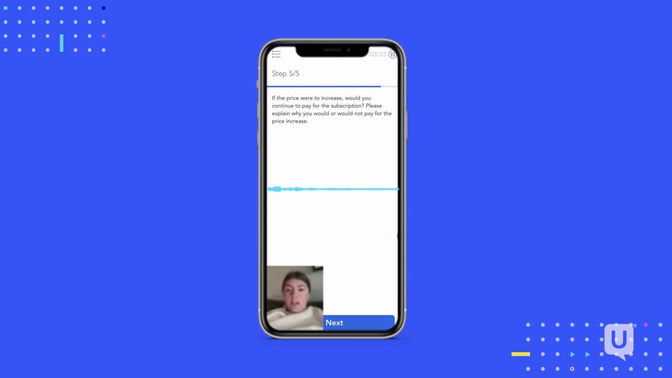
Feeding human insight across all elements of your business at every step of the way is essential to your success. Not asking these questions about your customer’s perceived value runs the risk of overspending on marketing and product development. You’ll end up with more free customers than paid, which returns you to square one in the funnel.
Retaining subscribers and increasing revenue when developing your model
So, how do you increase your revenue model when attempting to maintain loyalty?
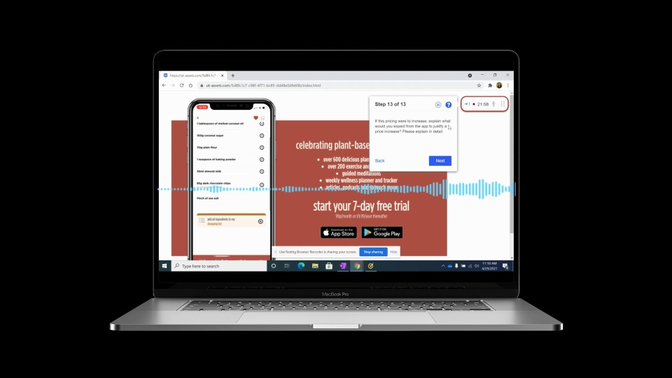
Step 1: understand the marketplace
Going from free to paid is a judgment on value. As value is relative, you must first understand who benefits most from your product or service. These customers will perceive the most value in what you do, and it's to these customers you must charge a premium.
Think of pricing holistically, marketing to the prospects most likely to buy a paid plan. The free tier then becomes an incentive to get them on board. However, this only works if:
- You've correctly identified who's most likely to benefit from your product.
- Identified their behaviours
- Provided a better product than competitors
- Capitalised on trends in the market
Step 2: audience segmentation
Think about your audience segmentation, and try to understand the varying demographic opportunities and key partnership opportunities. Everyone has a different need. The pandemic has seen a surprising increase in time spent on apps coming from Gen X/Baby Boomers.
Defining the key subgroups of your user base by demographics, interests, and app activities will help you to understand each segment’s unique needs and motivations to create targeted campaigns. This has been found to increase conversions by 200%. By targeting your messaging to customers based on their actual interests and behaviour, you can increase the chances that they decide to subscribe, boosting overall revenue.
Step 3: consider customer needs
A customer need is a motive that prompts a customer to buy a product or service. Ultimately, the need is the driver of the customer's purchase decision. Think about how a customer interacts with your app, what do they expect? Take a Health & Fitness app, for example, they’ll be looking for experience, convenience, and control options. All these need one simple transaction.
Innovate more effectively by learning and iterating throughout the lifecycle
Iteration from ideation to implementation is something that shouldn’t be ignored, even if your initial launch is successful. Understanding the customer’s “why” throughout the lifecycle before launching your product into a new market, then iterating on this research to hone in on the best solution for the target market.
Going from free to paid is a judgment on value. As value is relative, you must first understand who benefits most from your product or service. From understanding the marketplace and competitive landscape to validating ideas and concepts before launch, you can reduce risks after the app launches.
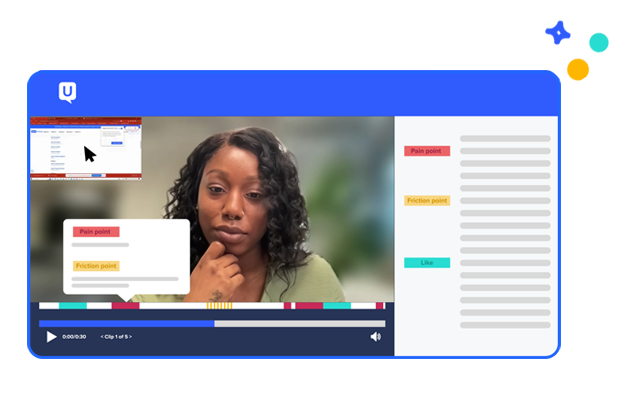
Get actionable insights today
Uncover human insights that make an impact. Book a meeting with our Sales team today to learn more.





